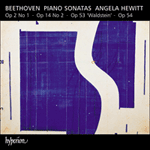
Welcome to Hyperion Records, a British classical label devoted to presenting high-quality recordings of music of all styles and from all periods from the twelfth century to the twenty-first.
Hyperion offers both CDs, and downloads in a number of formats. The site is also available in several languages.
Please use the dropdown buttons to set your preferred options, or use the checkbox to accept the defaults.

The sonata’s opening movement is largely based on the opposition between a toccata-like main subject and a broad second theme in the style of a chorale. Beethoven had tried a similar juxtaposition some seven years earlier in his Sonata Op 7, but the ‘Waldstein’ brings into play a new element of contrast: the second subject occurs in the radiant, and comparatively distant, key of E major. The remoteness of the chorale theme’s key lends it an expressive serenity it would not otherwise have achieved.
Beethoven first conceived the ‘Waldstein’ as a large-scale work in three discrete movements, but he eventually removed the middle movement (it was issued separately in September 1805, some four months after the Sonata, and became popular enough to earn itself the title of Andante favori), and in its place wrote a concentrated and dramatic introduction to the finale. Beethoven may well have felt the original Andante was stylistically old-fashioned in comparison to the remainder of the work, but the new plan heralded a general move on his part away from the concept of a sonata as consisting of three self-contained movements. Apart from the Op 79 ‘Sonatine’, the half-dozen sonatas Beethoven composed following the ‘Waldstein’ consist either of two movements only (Opp 54, 78 and 90), or—like the ‘Waldstein’—of three movements telescoped into two (the ‘Appassionata’ Op 57, ‘Les Adieux’ Op 81a).
The introduction with which Beethoven prefaces the ‘Waldstein’ Sonata’s rondo ends with a sustained, accented note G—the pitch around which the rondo theme itself is to oscillate. Underpinning that theme, and sounded before it begins, is a low C in the left hand, so that the theme’s top G is heard almost as an overtone of the bass note. Beethoven’s interest in exploiting the piano’s resonance is further shown by his pedal markings for the rondo’s theme, which require the player to hold the sustaining pedal down not only through changes of harmony, but also through alternations between major and minor.
An even more ethereal sonority seems to be indicated in the movement’s Prestissimo coda, where similar pedal markings accompany an appearance of the theme shrouded in trills. As if the trills were not enough, Beethoven brings another virtuoso device into play: pianissimo glissandos in octaves for both hands, moving in opposite directions. The effect was relatively easy to bring off on the pianos of Beethoven’s day, with their narrower keys and shallower action, but on a modern concert grand it is much less feasible to play the passages in question without a discreet redistribution of notes between the hands. In the final bars Beethoven sets the piano’s strings in vibration one last time, with a triumphant series of fanfares.
from notes by Misha Donat © 2010
Le premier mouvement de la sonate repose largement sur l’opposition entre un sujet principal comparable à une toccata et un large second thème dans le style d’un choral. Beethoven avait essayé une juxtaposition analogue sept ans plus tôt dans sa Sonate, op. 7, mais la «Waldstein» fait intervenir un nouvel élément de contraste: le second sujet se présente dans la tonalité rayonnante et relativement éloignée de mi majeur. L’éloignement de la tonalité du thème choral lui prête une sérénité expressive qu’il aurait été impossible d’obtenir autrement.
Beethoven a tout d’abord conçu la «Waldstein» comme une œuvre d’envergure en trois mouvements distincts, mais il a finalement retiré le mouvement central (il a été publié séparément en septembre 1805, environ quatre mois après la sonate, et est devenu assez populaire pour se gagner le titre d’Andante favori); à sa place, il a écrit une introduction concentrée et dramatique au finale. Beethoven a peut-être pensé que l’Andante original était démodé sur le plan stylistique par rapport au reste de l’œuvre, mais le nouveau plan consacre une mise à l’écart générale de sa part du concept de sonate en trois mouvements autonomes. En dehors de la «Sonatine», op. 79, la demi-douzaine de sonates que Beethoven a composées à la suite de la «Waldstein» comportent soit deux mouvements seulement (op. 54, 78 et 90), soit—comme la «Waldstein»—trois mouvements regroupés en deux (l’«Appassionata», op. 57, «Les Adieux», op. 81a).
L’introduction avec laquelle Beethoven préface le rondo de la Sonate «Waldstein» s’achève par une note accentuée et soutenue, sol—la hauteur de son autour de laquelle va osciller le thème du rondo lui-même. Un do grave à la main gauche étaye ce thème et se fait entendre avant qu’il ne commence, si bien qu’on perçoit le sol aigu du thème presque comme une harmonique de cette note grave. L’intérêt que portait Beethoven à l’exploitation de la résonance du piano ressort encore de ses indications de pédale pour le thème du rondo: l’instrumentiste doit tenir la pédale forte enfoncée non seulement au travers des changements d’harmonie, mais également pendant les alternances entre majeur et mineur. Et une sonorité encore plus éthérée semble indiquée dans la coda Prestissimo du mouvement, où des indications de pédales analogues accompagnent l’apparition du thème enveloppé de trilles. Comme si les trilles ne suffisaient pas, Beethoven fait entrer en jeu un autre procédé de virtuosité: des glissandos pianissimo en octaves aux deux mains, allant dans des directions opposées. L’effet était relativement facile à faire ressortir sur les pianos de l’époque de Beethoven, avec leurs touches plus étroites et leur mécanisme qui réclamait un moindre enfoncement des touches par rapport aux pianos modernes, mais sur un piano de concert actuel il est beaucoup plus difficile de jouer les passages en question sans une redistribution discrète des notes entre les deux mains. Dans les dernières mesures, Beethoven met une dernière fois en vibration les cordes du piano, avec une série triomphale de fanfares.
extrait des notes rédigées par Misha Donat © 2010
Français: Marie-Stella Pâris
Der erste Satz der Sonate basiert weitgehend auf dem Gegensatz zwischen dem Tokkata-ähnlichen Hauptthema und einem breiten zweiten Thema im Stil eines Chorals. Sieben Jahre zuvor hatte Beethoven eine ähnliche Gegenüberstellung in der Sonate op. 7 versucht, doch die „Waldstein“-Sonate führt ein neues kontrastierendes Element ein, wenn das zweite Thema in strahlendem und relativ entferntem E-Dur erscheint. Die Ferne der Tonart des Choralthemas verleiht dem Stück eine ausdrucksvolle Gelassenheit, die nur auf diese Weise erzielt werden kann.
Beethoven konzipierte die „Waldstein“-Sonate ursprünglich als groß angelegtes Werk in drei getrennten Sätzen, ersetzte den mittleren Satz (der rund vier Monate später, im September 1805, als eigenständiges Werk veröffentlicht wurde und aufgrund seiner Beliebtheit den Beinamen Andante favori erhielt) jedoch durch eine konzentrierte, dramatische Einleitung zum Finalsatz. Vielleicht hielt er das ursprüngliche Andante für stilistisch altmodisch im Vergleich zum übrigen Werk, doch der neue Plan kündigte auch seine allgemeine Abwendung von der traditionellen Sonatenform mit ihren drei in sich geschlossenen Sätzen an. Abgesehen von der „Sonatine“ op. 79 besteht das halbe Dutzend nach der „Waldstein“-Sonate komponierter Sonaten entweder aus jeweils zwei Sätzen (opp. 54, 78 und 90) oder, wie die „Waldstein“-Sonate, aus drei Sätzen, von denen zwei miteinander verbunden sind („Appassionata“ op. 57 und „Les Adieux“ op. 81a).
Die Einleitung zum Rondo der „Waldstein“-Sonate endet mit einem betont ausgehaltenen G, um das dann auch das Rondo-Thema selbst oszilliert. Zur Abstützung dieses Themas erscheint noch vor seinem Beginn ein tiefes C in der linken Hand, so dass das hohe G des Themas beinahe als Oberton dieser Bassnote erklingt. Beethovens Interesse an der Ausschöpfung der Klangfülle des Klaviers wird weiterhin deutlich in seinen Pedalmarkierungen für das Rondothema, die das Dämpferpedal nicht nur während harmonischer Wechsel, sondern auch während der Übergänge zwischen Dur und Moll verlangen.
Eine noch ätherischere Klangfülle scheint in der Prestissimo-Coda des Satzes angezeigt, wo ähnliche Pedalmarkierungen das Thema in Triller hüllen, und als seien ihm diese Triller noch nicht genug, bringt Beethoven einen weiteren virtuosen Kunstgriff mit Pianissimo-Glissandi in Oktaven für beide Hände in gegenläufiger Richtung ein. Dieser Effekt war auf den Klavieren seiner Zeit mit ihren schmaleren Tasten und flacherem Anschlag vergleichsweise leicht zu erzielen, doch auf einem modernen Konzertflügel können diese Passagen nur mit umsichtiger Umverteilung der Noten zwischen den Händen gespielt werden. In den Schlusstakten versetzt Beethoven die Saiten noch einmal in Schwingung und beendet den Satz mit einer Folge triumphierender Fanfaren.
aus dem Begleittext von Misha Donat © 2010
Deutsch: Henning Weber
 Beethoven: Beethoven Unbound Beethoven: Beethoven UnboundA comprehensive new cycle of the Beethoven sonatas recorded live at London's Wigmore Hall during the pianist's epic fourth rendition of these masterpieces .» More |
 Beethoven: Piano Sonatas Opp 2/1, 14/2, 53 & 54 Beethoven: Piano Sonatas Opp 2/1, 14/2, 53 & 54The penultimate release in Angela Hewitt’s cycle of the complete Beethoven piano sonatas takes in the ‘Waldstein’.» More |
 Jimmy Rhodes Live in Brighton Jimmy Rhodes Live in BrightonThis new album—recorded live at The Old Market theatre in Brighton—captures the energy of Rhodes in concert as he performs and entertainingly discusses works by Bach, Beethoven, Chopin, Rachmaninov and more in this 85-minute programme.» More |

